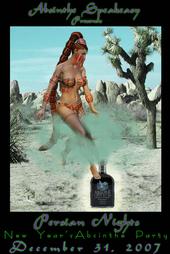WHAT IS ABSINTHE?
Absinthe is strong alcoholic liqueur made with wormwood (Artemisia absinthium). It is an emerald green drink (due to the presence of chlorophyll) which is very bitter (due to the presence of absinthin, which has a bitterness threshold of 1:70,000) and is therefore traditionally diluted with cold water which is poured over a perforated spoonful of sugar into a glass containing a shot of absinthe. The drink then turns into an opaque white as the essential oils precipitate out of the alcoholic solution, forming a colloidal suspension. Absinthe was once popular among artists and writers and was used by Van Gogh, Baudelaire, and Verlaine, to name a few. It appears to have been believed to stimulate creativity and to act as a curative and aphrodisiac.
The 1850's saw the beginnings of concern about the results of chronic absinthe use. Chronic use was believed to produce a syndrome, called absinthism, which was characterized by addiction, epileptic attacks, delirium, and hallucinations. Concern over the health effects of absinthe was amplified by the prevailing belief in Lamarckian theories of heredity. In other words, it was believed that any traits acquired by absinthists would be passed on to their children (Murphy and Schneider 1992).
In addition to its effects in heavy drinkers, there were several social reasons why absinthe was ultimately banned. Absinthe's popularity seems to have been part of a general increase in alcohol consumption, particularly in the form of distilled liqueurs. This was accompanied by the beginnings of the awareness of alcoholism as a problem in France. Since wine was considered a healthy drink and absinthe was the most popular liqueur of its time, absinthe was blamed for many alcohol-related problems and became the main target of early prohibition efforts in France. Absinthe's association with the bohemian lifestyle may have worked to compound fears about its effects, much as has happened with marijuana in the United States. In retrospect, absinthe seems to have become the focus of fears about the changes that came with industrialization. Absinthe was subsequently banned in many countries in the early 1900's.
In addition to the many social and political factors which contributed to anti-absinthe sentiment, extensive research documented absinthe's potential for toxicity. From a modern perspective, this research appears poorly designed and limited. Nonetheless, it is clear that absinthe had toxic effects when consumed with sufficient quantities and regularity. It is highly plausible that thujone and related terpenes played an important role in this toxicity, but there are also other possible sources of toxicity. When used in sufficient quantities, ethanol has profound toxic effects. If it is likely that absinthe was toxic to heavy users, it is less clear that the liqueur was uniquely psychoactive. Until more conclusive research is carried out, theories of absinthe's special psycho activity remain interesting speculation and anecdotes.
HOW WAS/IS ABSINTHE DRUNK?
Absinthe Spoon Although absinthe was sometimes drunk straight or in a variety of mixed drinks, the classic method of drinking it involves pouring cold water over a slotted spoon which contains sugar into a glass containing a shot of absinthe. As the water hits the absinthe, the oils precipitate out, and the drink changes from a clear emerald color to an opaque, milky white.
There were several types of specialized absinthe drinking paraphernalia. The most famous one is the slotted spoon (example pictured to the right). These spoons' holes served to allow the absinthe to better carry the sugar into the glass. In addition, the spoons were often designed to fit over the glass, balancing on their own.
A variation of the traditional drinking ritual is apparently used in Prague where absinthe is currently available. In this variation, a heaping teaspoon of sugar is briefly wet in the glass of pure absinthe, then lit on fire and held over the glass. As the alcohol burns off, the sugar melts into the glass. When the fire gets low, the remaining sugar is stirred into the drink and the drink is quickly drunk. Obviously, this is a method for drinking quickly rather than savoring absinthe's taste.
